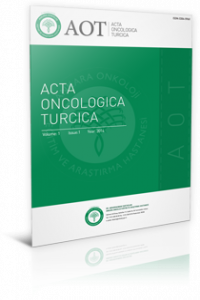Evaluation of Quinolone Susceptibility in Orthopedic Infections
Kinolon, ortopedik infeksiyon.
Ortopedik Yara Kültürlerinde Üreyen Mikroorganizmaların Kinolon Duyarlılığının Değerlendirilmesi
ûuinolon, orthopedic infection.,
___
- Daniel P, Francis A. Use of quinolones in osteomyelitis and infected orthopaedic prosthesis. Druds 1999;Suppl 2:85-91.
- Fong I, Ledbetter W, Vandenbroucke A, et al. Ciprofloxacin concentrations in bone and muscle after oral dosing. Antimicrob Agents Chemother 1986;29:405-8.
- Darley E, MacGovvan A. Antibiotic treatment of gram-posi- tive bone and joint infections. J Antimicrob Chemother 2004;53:928-35.
- Greenberg R, Newman M, Shariaty S, et al. Ciprofloxacin, lomefloxacin or levofloxacin as treatment for chronic osteomyelitis. Antimicrob Agents Chemother 2000;44:164-6.
- Drancourt M, Stein A, Argenson J, et al. Oral treatment of Staphylococcus spp. infected orthopedic implants with fucidic acid or ofloxacin in combination with rifampicin. J Antimicrob Chemother 1997;39:235-40.
- Drancourt M, Stein A, Argenson J, et al. Oral rifampin plus ofloxacin for treatment of Staphylococcus-infected orthope dic implants. Antimicrob Agents Chemother 1993:1214-8.
- Brouqui P, Rousseau M, Stein A, et al. Treatment of Pseudomonas aeruginosa-infected orthopedic prostheses with ceftazidime-ciprofloxacin antibiotic combination. Antimicrob Agents Chemother 1995;39:2423-5.
- Gesu G, Marchetti F, Picconi L, et al. Levofloxacin and ciprofloxacin in vitro activities against 4003 clinical bacteri- al isoiates collected in 24 Italian laboratoies. Antimicrob Agents Chemother 2003;47:816-9.
- TrampuzA, VVidmer A. İnfections associated with orthopedic implants. Curr Opin Infect Dis 2006;19:349-56.
- Bernard L, Hoffmeyer P, Assai M, et al. Trends in the treat ment of orthopedic prosthetic infections. J Antimicrob Chemother 2004;53:127-9.
- ISSN: 0304-596X
- Başlangıç: 2015
- Yayıncı: Dr. Abdurrahman Yurtaslan Ankara Onkoloji EAH
Fetal Ouadrigeminal Arachnoid Cyst Secondary to Usage of Valproic Acid
Gülşah Bayram KABAÇAM, Z. Nilgün Yildirim ÖZBAY, Bige SAYIN, Perihan SOYDİNÇ, Doğan DEDE
Management of Menopausal Symptoms in Patients Breast Cancer
Metachronous Thymoma and Nonsmall Celi Lung Cancer A Case Report
Yeşim ELGİN, Aytül ÖZGEN, Bülent KÜÇÜKPLAKÇI, Ergun SANRI, Cem MISIRLIOĞLU, Taciser DEMİRKASIMOĞLU, V. Işıl UĞUR, Ş. Pınar KARA, Nadi ÖZDAMAR
The Efficacy of US-Guided Fine-Needle Aspiration Biopsy in Adrenal Masses
Bilgin Kadri ARIBAŞ, Gürbüz DİNGİL, Ümit ÜNGÜL
The Value of A Second Transurethral Resection in Patients with Superficial Bladder Cancer
Fatih HIZLI, Yurdaer KAYNAK, Emine BENZER, Ferhat BERKMEN
Oğuz TARCAN, Haluk ULUCANLAR, Aybala AĞAÇ, Suat KUTUN, Necmi YÜCEKULE, Abdullah ÇETİN
Kaptan GÜLBEN, Mustafa YİĞİT, Uğur BERBEROĞLU
Evaluation of Quinolone Susceptibility in Orthopedic Infections
Kamuran SAYILIR, M. Cihat OĞAN, Gülşen İSKENDER, Müfide ÇİMENTEPE, Yaman KARAKOÇ
Mature Teratoma of the Uterine Cervix
Jale METİNDİR, Zeynep KAHYAOĞLU, Süleyman DEMİR
Bilgin Kadri ARIBAŞ, Dilek Nil ÜNLÜ, Gürbüz DİNGİL, Sevim ÖZDEMİR, Pelin DEMİR, Zekiye Pekol ŞİMŞEK, Ümit ÜNGÜL, Aliye Ceylan ZARALI
